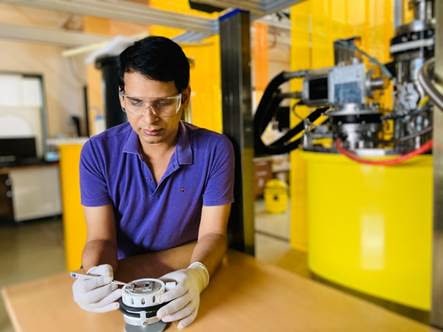
Pabitra K. Nayak, reader at Tata Institute of Fundamental Research-Hyderabad and Swarnajayanti fellow for the year 2020-21, is leading a research group for the development of efficient next-generation low-cost semiconductor materials which can contribute to India’s technological leadership in this area.
India has recently announced incentives of INR 2,30,000 crore to position India as global hub for electronics manufacturing with semiconductors as the foundational building block and efficient next-generation low-cost semiconductor materials could pave the path towards positioning India as the global hub for Electronic System Design and Manufacturing as per the vision of Aatmanirbhar Bharat.
Large-scale commercially viable electronic applications can be realized by low-energy processible materials like metal halide perovskite and organic semiconductors. However, in competing with traditional inorganic semiconductors, organic materials and halide perovskites still lag in electrical conductivity. This lag can be addressed through doping to introduce more numbers of free electrons (or holes) increase conductivity, or to control the charge injection /extraction properties at the interface of other semiconductors or metals, thus affecting the performance of devices.
Most of the attention of the research community has been in developing electronic dopants systems that are based on highly complex and reactive organic or organometallic complexes, which are largely inefficient and leave behind side products which affects the long-term stability of devices. Thus there is a need to look beyond these approaches and beyond the state-of-the-art research in electronic doping.
In a paper published in Nature Materials, Dr. Nayak has shown the very first example of an adduct-based dopant system (impurities that can change the electrical conductivity of semiconductors) for organic semiconductors, where the dopants do not leave behind any side products and work better than the existing class of dopants. He has also made seminal contributions towards the understanding of crystallization and doping in halide perovskites, a class of materials that are driving the progress of emerging solar cell technologies.
Dr. Nayak, who won the SwarnaJayanti fellowship of the Department of Science and Technology (DST), now aims to develop new doping agents based on molecular adducts (a molecular species formed out of a combination of multiple distinct molecules) and radicals for efficient and clean electronic doping of different types of semiconductors. He hopes that this will help in coming up with new systems which will have better performance.
His group will investigate the mechanism of p-type and n-type electronic doping of organic and metal halide perovskite semiconductors. Processes will be developed to neutralize electronic defects, which are often responsible for poor device performances. New doping methods and materials developed by the group will be used to realize the state-of-the-art perovskite and organic-based solar cells, light-emitting devices, and transistors and heterostructures. The new doping methods and dopants are expected to cause a paradigm shift in the doping of soft semiconductors as they will end our dependency on highly expensive dopant molecules. The new generation of dopants will drive the next revolution in displays, solar cells, and bio-electronics by improving their efficiency and stability. This will enable the wider application of low-cost and printable electronics.
Dr Nayak pointed out that all these possibilities will improve India’s competitiveness in semiconductor materials research and development, which is essential for sustainable socio-economic growth driven by the usage of clean energy.
(For more details, Pabitra Kumar Nayak(pabitra.nayak@tifrh.res.in) can be contacted)